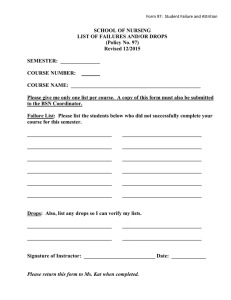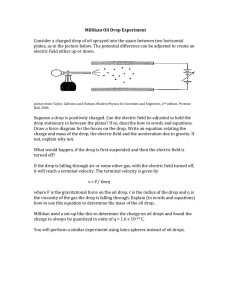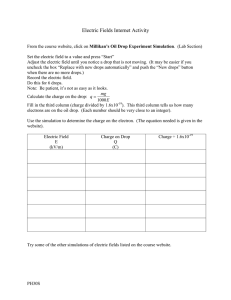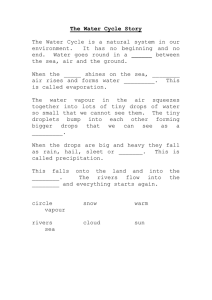Physics 475: Millikan Oil Drop
advertisement
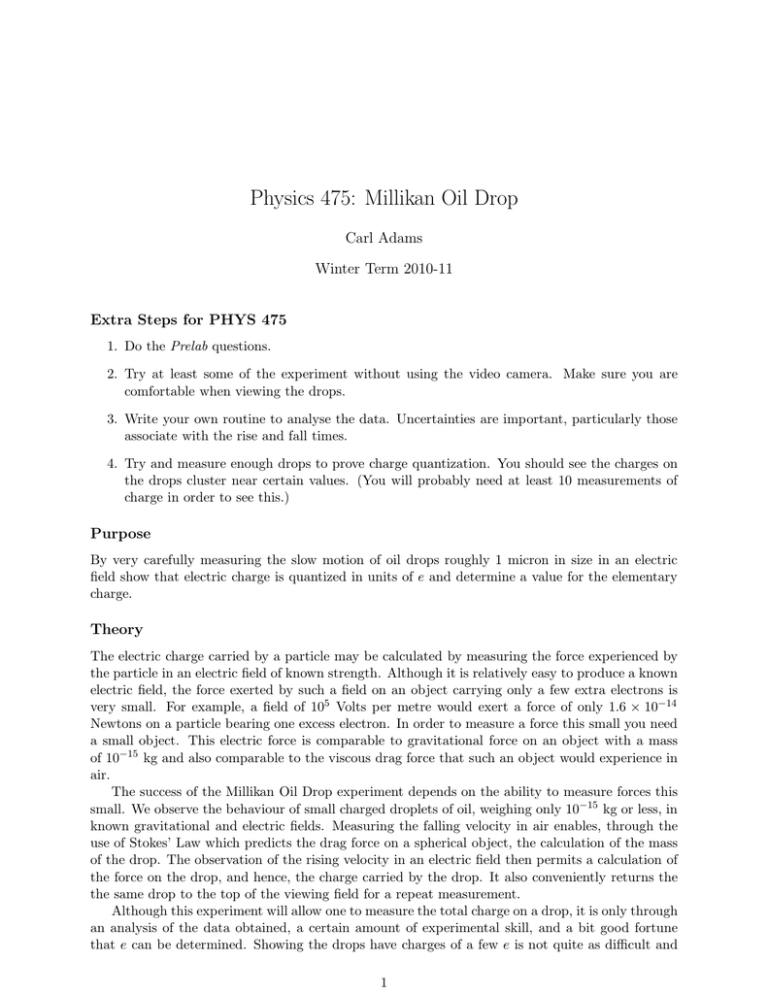
Physics 475: Millikan Oil Drop Carl Adams Winter Term 2010-11 Extra Steps for PHYS 475 1. Do the Prelab questions. 2. Try at least some of the experiment without using the video camera. Make sure you are comfortable when viewing the drops. 3. Write your own routine to analyse the data. Uncertainties are important, particularly those associate with the rise and fall times. 4. Try and measure enough drops to prove charge quantization. You should see the charges on the drops cluster near certain values. (You will probably need at least 10 measurements of charge in order to see this.) Purpose By very carefully measuring the slow motion of oil drops roughly 1 micron in size in an electric field show that electric charge is quantized in units of e and determine a value for the elementary charge. Theory The electric charge carried by a particle may be calculated by measuring the force experienced by the particle in an electric field of known strength. Although it is relatively easy to produce a known electric field, the force exerted by such a field on an object carrying only a few extra electrons is very small. For example, a field of 105 Volts per metre would exert a force of only 1.6 × 10−14 Newtons on a particle bearing one excess electron. In order to measure a force this small you need a small object. This electric force is comparable to gravitational force on an object with a mass of 10−15 kg and also comparable to the viscous drag force that such an object would experience in air. The success of the Millikan Oil Drop experiment depends on the ability to measure forces this small. We observe the behaviour of small charged droplets of oil, weighing only 10−15 kg or less, in known gravitational and electric fields. Measuring the falling velocity in air enables, through the use of Stokes’ Law which predicts the drag force on a spherical object, the calculation of the mass of the drop. The observation of the rising velocity in an electric field then permits a calculation of the force on the drop, and hence, the charge carried by the drop. It also conveniently returns the the same drop to the top of the viewing field for a repeat measurement. Although this experiment will allow one to measure the total charge on a drop, it is only through an analysis of the data obtained, a certain amount of experimental skill, and a bit good fortune that e can be determined. Showing the drops have charges of a few e is not quite as difficult and 1 (a) (b) + bvf qE mg mg bvf − Figure 1: (a) Free-body diagram for a falling oil droplet. When terminal velocity is reached the gravitational and viscous force are even and opposite. (b) Free-body diagram for a rising droplet with some charge q (assumed negative). The electric field has magnitude E and is directed in the downward direction so the upward force on a negative charge is qE. this is all that is expected for an experiment running for a single afternoon. By selecting drops which rise and fall slowly, one can be certain that the drop has a small number of excess electrons. A number of such drops should be observed, and their respective charges calculated. If the charges on these drops are integral multiples of a certain smallest charge, there is a good indication of the quantized nature of electricity. Let’s analyse the forces acting on an oil droplet when rising and falling to obtain the formula for electric charge. Figure 1(a) shows the forces acting on the drop when it is falling in air and has reached its terminal velocity. (Terminal velocity is reached within a few milliseconds for the droplets used in this experiment. In essence the air is just like thick molasses for drops that are this size.) In Fig. 1(a), vf is the velocity of the fall, b is the damping coefficient between the air and the drop, m is the mass of the drop, and g is the acceleration due to gravity. The viscous force on the drop is proportional to vf as long as vf is small and b is the constant of proportionality that is given by Stokes’ Law. Since the viscous and gravitational forces are equal and opposite when the droplet moves at a constant terminal velocity mg = bvf . (1) Figure 1(b) shows the forces acting on a drop when it is rising under the influence of the electric field. E is the magnitude of the electric field, q is the charge on the drop, and vr is the velocity of rise. Adding the forces vectorially yields qE = mg + bvf . (2) In both cases there is a small buoyant force exerted by the air on the droplet. However, since the density of air is about one thousandth that of oil, this force may be neglected. Eliminating b from equations 1 and 2, and solving for q yields q= mg(vf + vr ) . Evf (3) To eliminate m from equation 3, one uses the expression for the volume of a sphere 4 m = πa3 ρ 3 (4) where a is the radius of the droplet, and ρ is the density of the oil. To calculate a, one employs Stokes’ Law, relating the radius of a spherical body to its damping coefficient. Stokes’ Law says 2 that b for a spherical body in a viscous medium (with the coefficient of viscosity η) is b = 6πηa. (5) When combined with equations 1 and 4 this yields an expression for the radius a= s 9ηvf 2gρ (6) giving the result for the total charge 4 q= π 3 s 1 gρ 9η 2 3 × vf + vr √ vf . E (7) However, Stokes’ Law is not correct when the velocity of fall of the droplets is less than 10−3 m/s. (Droplets having this and smaller velocities have radii on the order of 2 µm, comparable to the mean free path of air molecules. This violates one of the assumptions made in deriving Stokes’ Law.) Since the droplets used in this experiment will have velocities in the range 10−4 to 10−5 m/s, a correction factor must be introduced into the expression for q. This factor is 1 k 1 + aP !3 2 (8) where k is a constant, P is the atmospheric pressure, and a is the raduis of the drop as calculated by equation 6. The magnitude of the electric field E for a parallel plate capacitor is given by E = V /d where V is the potential difference between the plates and d is the plate separation (provided that d is much smaller than the lateral dimension of the plates and you are not near the edge of the plates). Substituting this expression and correcting factor 8 into equation 7 yields 4 q = πd 3 1 9η ρg 2 3 !1/2 1 × k 1 + aP !3 2 × vf + vr √ vf . V (9) The terms in the first set of brackets need only to be determined once for any particular apparatus. The second and third terms are calculated for each drop. The definitions and units for these terms are: q: d: g: ρ: η: k: P: a: vf : vr : V: charge carried by the droplet (Coulombs) separation of the capacitor plates (m) acceleration due to gravity (didn’t we measure this?) density of the oil (roughly 886 kg/m3 ) viscosity of air (1.86 × 10−5 Newton sec / m2 at room temperature) correction factor for small drops (6.170 × 10−5 mmHg m) barometric pressure (mmHg) radius of drop from equation 6 (m) velocity of fall of the drop (m/s) velocity of rise of the drop (m/s) potential difference between the plates (volts) I have written a perl script called millikan.pl that is in the millikan directory on one of the lab computers running linux. It can be a big help in the calculations. 3 Adjustment and Calibration of the Apparatus 1. Setting up: The apparatus and ring stand assembly should be placed on a solid table with the viewing scope at a comfortable height when seated. You do not need to bring your eye right up to the telescope (so wearing glasses is fine). You will probably find that a couple of centimetres away is a good position. This distance is known as the eye relief. The scope of a high powered rifle is another instance where a few cm of eye relief is desirable. 2. Level the unit using the bubble level installed in the apparatus. Make sure the unit is level or the drops will drift out of the focal region of the telescope. You may need to fine adjust the level if you find your drops are moving either sideways or back to front. 3. You need to disassemble the unit to clean the plates. Make sure the paddle is in its central position when disassembling or touching the top plate. The capacitor is disassembled by removing the following parts (Fig. 2): A: Housing cover, B: Housing, C: Droplet Hole Cover D: Top Plate, E: Plastic Spacer. Note: take care while handling the brass plates to ensure that no scratches or pits are formed on the inner sides of either plate. 4. Measuring plate separation: The distance between the capacitor plates is determined by measuring the thickness of the plastic spacer used to separate the plates. Two possible methods are suggested for making this measurement: (a) The thickness of the plastic spacer is measured with a micrometer in several places around the outer rim and an average is taken. (b) A more accurate method is to place the spacer between two small pieces of plate glass and measure the combined thickness. The thickness of the glass plates is then measured, and subtracted from the thickness of the combination. This method has the advantage that it takes into account any surface imperfections on the brass plates. 5. Cleaning and reassembly: The capacitor assembly should cleaned. Methanol is excellent for this purpose. All parts should be completely dry before reassembly. Do not put the housing cover back on until checking the focusing. The two glass ports on the housing should line up with the telescope and light source. 6. The apparatus use an external voltage source. A DC voltmeter should be connected across the binding posts for measuring plate potential. (Turn it to the high voltage setting.) Recommended voltage: 370 V. A warm-up period of at least 5 minutes is required for the power supply to stabilize. You can leave it on stand-by for this warm-up period. 7. The light source on the back right hand side is powered from an AC adapter.. Plug it in. 8. Adjusting the optical system: Adjust the reticule focus first. There is a wire that is attached to larger piece of threaded plastic. This piece is threaded into the top of the apparatus just to the right of the capacitor. Use this larger piece to hold the wire as you slide it down through the hole in the top plate. Adjust the focus knob until the bit is in sharp focus. (The room should be fairly dark for this procedure.) You should be able to clearly see a sharp image of the sides of the bit and perhaps some defects along the sides. It is crucial that the scope is properly focused. Also check that the wire is illuminated in the middle of the field of view. The wire will have its edges strongly illuminated but the side facing you will be invisible (the knob on the side of the back light housing adjusts this). Check the vertical alignment but adjusting the top knob on the back light housing. You should have the maximum brightness on the side of the focussing wire. 4 Figure 2: Parts for the capacitor and chamber. 9. Remove the focusing wire assembly from the top plate Put the droplet cover and the housing cover back in place. Now the background in the telescope should look black and but you should be able to faintly see the reticle. A “glow” is undesirable. 10. Turn the high voltage source to ON and check the voltage level. Functions and Controls 1. The spacing between major lines of the reticle is 0.5 mm. Find a microscope reticule if you would like to check this. The reticle lines appear black when viewing in ambient light. Measuring rise and fall times between these lines allows you to calculate vf and vr . You can use just one set of lines but you will probably get better data if you let the drops rise and fall through 1 mm rather than 0.5 mm. 2. Move it to the middle a position (I call it the “draught” position since it mimics the draught on a wood stove) when introducing drops to the chamber. Leave this in the “OUT” position when making measurements. Turn it to “IN” if you want to try and change the charge of a drop or if you would like to increase the likelihood of seeing a charged drop (rarely used). 3. Plates Switch: When the switch is in the “OFF” position, the plates are disconnected from the high voltage power supply and grounded. When the switch is in one of the “ON” positions, the plates are connected to the high voltage supply in accordance with the polarity switch position. 5 Procedure 1. The room should be dark as possible. 2. Introducing drops to the capacitor: Try squirting your hand or a piece of paper towel just to see what the spray is like and make sure it is working. It usually takes quite a few squeezes at the beginning of the lab to draw the oil up to the atomizer. The nozzle of the atomizer (spray bottle) is placed into the hole in the housing cover. Try one quick squirt but slowly pull the nozzle away before you release the bulb on the atomizer (or it will suck the drops right back out) You should see some drops but if not slowly squeeze the bulb with the nozzle back in place to help force the air carrying the droplets down into the chamber. If the optics are correct the drops should appear in the exact same area where you saw the focussing wire. You don’t want very many drops. You will only be looking at one at a time. If repeated squirts fail to produce any drops in the viewing area (they will look like small orangish points), but instead produce a bright haze in the viewing area, the droplet hole is probably clogged, and the capacitor and droplet cover should be cleaned. The capacitor must be kept meticulously clean at all times. The exact technique of introducing drops to the viewing area will have to be developed by the experimenter. 3. Move the lever back to the proper position. 4. Selection of a drop: From the drops in view, the experimenter should select a droplet which both falls slowly under the influence of gravity and rises slowly (preferrably 10 s between 0.5 mm reticle lines) when the plates are charged. Give the paddle a few flicks so you can see which drops are charged. Just try and pick out your favourite and let it rise and fall a few times before making measurements. By this time most of the other drops will hopefully have disappeared so it will be easier for you observe “your” drop. The other problem is that a “good drop” will sometimes fade from view. If this always happens at the same place you might want to adjust the angle of the light source. There can also be drafts (air currents) which force drops sideways or up even when the plates aren’t turned on. Avoid these drops. You should make up to 20 measurements each of the rising and falling times between the reticule lines. Also make a note if the drop rose with normal or reverse polarity. The reason for the large number of trials is to minimize the error made in calculating velocities (the dominant source of error). In practice, once you have 3 or 4 measurements of these times you can at least estimate the charge on the drop. Keep an eye out for changes in the times that can’t be accounted for by reaction time or your inability to judge exactly when the drop crosses the reticle line. You may have inadvertently switched drops or else the charge on that particular drop may have changed. 5. Try and make measurements on at least two drops and maybe up to five if you are really talented. 6. At some point use the mercury barometer in the lab prep area to measure atmospheric pressure. Analysis 1. For each rise and fall time you will end up with a collection of between 2 and 20 values. If possible you should make a histogram of the data set with the most values. (e.g. if your drop has fall time of roughly 10 s bin the data into .2 s bins from 8 s to 12 s. The histogram is the 6 number of occurences in that particular bin.) What does it look like (might look like a Bell curve in an ideal world)? Why is there a spread? Does the size of the spread correspond to anything meaningful? Are there outliers (or more technically crap)? Should they be included in your average? 2. All things being equal your reaction time with the watch and judgement for drops crossing the reticule are one of the biggest sources of error. These should be random errors (as opposed to systematic or reading errors) and will give you the spread you saw in the histogram. You can reduce the effect of random error by taking more measurements; the spread of the histogram won’t change but your ability to estimate the centre of the distribution or average will improve as √1N where N is the number of observations. I often estimate the error as the standard √ deviation divided by N but I wouldn’t push this any farther than 1 or 2 percent error in your average. 3. Although the derivation of Eqn. 9 is not all that hard I find working through it accurately rather tedious. I would recommend using a spread sheet, programmable calculator, or computer program to assist your efforts. I have a perl script that can do the job and it is on one of the lab computers running linux. 4. If you made enough measurements you would begin to see clustering around the integer multiples of the charge. (you could assign positive or negative signs based on the polarity used for that particular drop). Then you could assign likely integers to each drop and calculate e. If you don’t have many drops I would be more inclined to see which integer multiple of the known e comes close. Then make a plot of charge (y-axis) with error estimates (well, we can always dream!) versus assumed number of e (x-axis). This graph should be a straight line that comes very close or within the error bars. The slope will be e and the intercept should be very close to zero. 7
